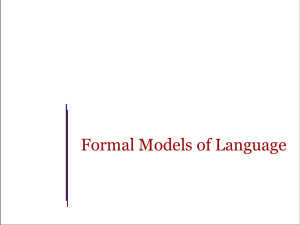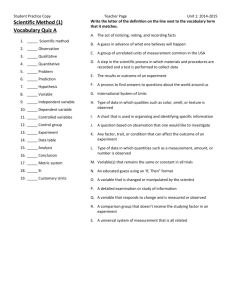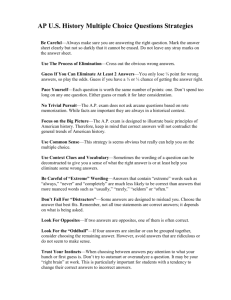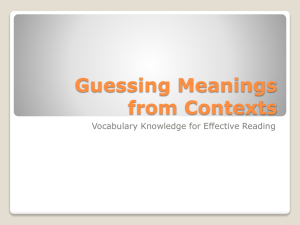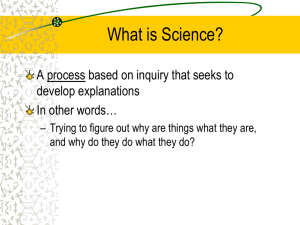03LanguageModels
advertisement
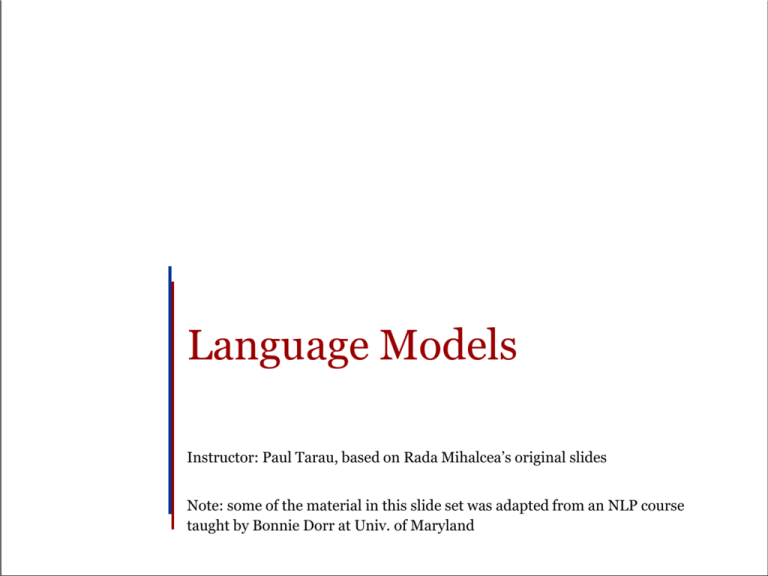
Language Models Instructor: Paul Tarau, based on Rada Mihalcea’s original slides Note: some of the material in this slide set was adapted from an NLP course taught by Bonnie Dorr at Univ. of Maryland Language Models A language model an abstract representation of a (natural) language phenomenon. an approximation to real language Statistical models predictive explicative Slide 1 Claim A useful part of the knowledge needed to allow letter/word predictions can be captured using simple statistical techniques. Compute: probability of a sequence likelihood of letters/words co-occurring Why would we want to do this? Rank the likelihood of sequences containing various alternative hypotheses Assess the likelihood of a hypothesis Slide 2 Outline • • • • • • Applications of language models Approximating natural language The chain rule Learning N-gram models Smoothing for language models Distribution of words in language: Zipf’s law and Heaps law Slide 3 Why is This Useful? Speech recognition Handwriting recognition Spelling correction Machine translation systems Optical character recognizers Slide 4 Handwriting Recognition Assume a note is given to a bank teller, which the teller reads as I have a gub. (cf. Woody Allen) NLP to the rescue …. gub is not a word gun, gum, Gus, and gull are words, but gun has a higher probability in the context of a bank Slide 5 Real Word Spelling Errors They are leaving in about fifteen minuets to go to her house. The study was conducted mainly be John Black. Hopefully, all with continue smoothly in my absence. Can they lave him my messages? I need to notified the bank of…. He is trying to fine out. Slide 6 For Spell Checkers Collect list of commonly substituted words piece/peace, whether/weather, their/there ... Example: “On Tuesday, the whether …’’ “On Tuesday, the weather …” Slide 7 Other Applications • Machine translation • Text summarization • Optical character recognition Slide 8 Outline • • • • • • Applications of language models Approximating natural language The chain rule Learning N-gram models Smoothing for language models Distribution of words in language: Zipf’s law and Heaps law Slide 9 Letter-based Language Models Shannon’s Game Guess the next letter: Slide 10 Letter-based Language Models Shannon’s Game Guess the next letter: W Slide 11 Letter-based Language Models Shannon’s Game Guess the next letter: Wh Slide 12 Letter-based Language Models Shannon’s Game Guess the next letter: Wha Slide 13 Letter-based Language Models Shannon’s Game Guess the next letter: What Slide 14 Letter-based Language Models Shannon’s Game Guess the next letter: What d Slide 15 Letter-based Language Models Shannon’s Game Guess the next letter: What do Slide 16 Letter-based Language Models Shannon’s Game Guess the next letter: What do you think the next letter is? Slide 17 Letter-based Language Models Shannon’s Game Guess the next letter: What do you think the next letter is? Guess the next word: Slide 18 Letter-based Language Models Shannon’s Game Guess the next letter: What do you think the next letter is? Guess the next word: What Slide 19 Letter-based Language Models Shannon’s Game Guess the next letter: What do you think the next letter is? Guess the next word: What do Slide 20 Letter-based Language Models Shannon’s Game Guess the next letter: What do you think the next letter is? Guess the next word: What do you Slide 21 Letter-based Language Models Shannon’s Game Guess the next letter: What do you think the next letter is? Guess the next word: What do you think Slide 22 Letter-based Language Models Shannon’s Game Guess the next letter: What do you think the next letter is? Guess the next word: What do you think the Slide 23 Letter-based Language Models Shannon’s Game Guess the next letter: What do you think the next letter is? Guess the next word: What do you think the next Slide 24 Letter-based Language Models Shannon’s Game Guess the next letter: What do you think the next letter is? Guess the next word: What do you think the next word is? Slide 25 Approximating Natural Language Words zero-order approximation: letter sequences are independent of each other and all equally probable: xfoml rxkhrjffjuj zlpwcwkcy ffjeyvkcqsghyd Slide 26 Approximating Natural Language Words first-order approximation: letters are independent, but occur with the frequencies of English text: ocro hli rgwr nmielwis eu ll nbnesebya th eei alhenhtppa oobttva nah Slide 27 Approximating Natural Language Words second-order approximation: the probability that a letter appears depends on the previous letter on ie antsoutinys are t inctore st bes deamy achin d ilonasive tucoowe at teasonare fuzo tizin andy tobe seace ctisbe Slide 28 Approximating Natural Language Words third-order approximation: the probability that a certain letter appears depends on the two previous letters in no ist lat whey cratict froure birs grocid pondenome of demonstures of the reptagin is regoactiona of cre Slide 29 Approximating Natural Language Words Higher frequency trigrams for different languages: English: German: French: Italian: Spanish: THE, ING, ENT, ION EIN, ICH, DEN, DER ENT, QUE, LES, ION CHE, ERE, ZIO, DEL QUE, EST, ARA, ADO Slide 30 Language Syllabic Similarity Anca Dinu, Liviu Dinu Languages within the same family are more similar among them than with other languages How similar (sounding) are languages within the same family? Syllabic based similarity Slide 31 Syllable Ranks Gather the most frequent words in each language in the family; Syllabify words; Rank syllables; Compute language similarity based on syllable rankings; Slide 32 Example Analysis: the Romance Family Syllables in Romance languages Slide 33 Latin-Romance Languages Similarity servus servus ciao Slide 34 Outline • • • • • • Applications of language models Approximating natural language The chain rule Learning N-gram models Smoothing for language models Distribution of words in language: Zipf’s law and Heaps law Slide 35 Terminology Sentence: unit of written language Utterance: unit of spoken language Word Form: the inflected form that appears in the corpus Lemma: lexical forms having the same stem, part of speech, and word sense Types (V): number of distinct words that might appear in a corpus (vocabulary size) Tokens (NT): total number of words in a corpus Types seen so far (T): number of distinct words seen so far in corpus (smaller than V and NT) Slide 36 Word-based Language Models A model that enables one to compute the probability, or likelihood, of a sentence S, P(S). Simple: Every word follows every other word w/ equal probability (0-gram) Assume |V| is the size of the vocabulary V Likelihood of sentence S of length n is = 1/|V| × 1/|V| … × 1/|V| If English has 100,000 words, probability of each next word is 1/100000 = .00001 Slide 37 Word Prediction: Simple vs. Smart • Smarter: probability of each next word is related to word frequency (unigram) – Likelihood of sentence S = P(w1) × P(w2) × … × P(wn) – Assumes probability of each word is independent of probabilities of other words. • Even smarter: Look at probability given previous words (N-gram) – Likelihood of sentence S = P(w1) × P(w2|w1) × … × P(wn|wn-1) – Assumes probability of each word is dependent on probabilities of other words. Slide 38 Chain Rule Conditional Probability P(w1,w2) = P(w1) · P(w2|w1) The Chain Rule generalizes to multiple events P(w1, …,wn) = P(w1) P(w2|w1) P(w3|w1,w2)…P(wn|w1…wn-1) Examples: P(the dog) = P(the) P(dog | the) P(the dog barks) = P(the) P(dog | the) P(barks| the dog) Slide 39 Relative Frequencies and Conditional Probabilities Relative word frequencies are better than equal probabilities for all words In a corpus with 10K word types, each word would have P(w) = 1/10K Does not match our intuitions that different words are more likely to occur (e.g. the) Conditional probability more useful than individual relative word frequencies dog may be relatively rare in a corpus But if we see barking, P(dog|barking) may be very large Slide 40 For a Word String In general, the probability of a complete string of words w1n = w1…wn is P(w1n) = P(w1)P(w2|w1)P(w3|w1..w2)…P(wn|w1…wn-1) n = P ( wk | w1k 1) k 1 But this approach to determining the probability of a word sequence is not very helpful in general – gets to be computationally very expensive Slide 41 Markov Assumption How do we compute P(wn|w1n-1)? Trick: Instead of P(rabbit|I saw a), we use P(rabbit|a). This lets us collect statistics in practice A bigram model: P(the barking dog) = P(the|<start>)P(barking|the)P(dog|barking) Markov models are the class of probabilistic models that assume that we can predict the probability of some future unit without looking too far into the past Specifically, for N=2 (bigram): P(w1n) ≈ Πk=1 n P(wk|wk-1); w0 = <start> Order of a Markov model: length of prior context bigram is first order, trigram is second order, … Slide 42 Counting Words in Corpora What is a word? e.g., are cat and cats the same word? September and Sept? zero and oh? Is seventy-two one word or two? AT&T? Punctuation? How many words are there in English? Where do we find the things to count? Slide 43 Outline • • • • • • Applications of language models Approximating natural language The chain rule Learning N-gram models Smoothing for language models Distribution of words in language: Zipf’s law and Heaps law Slide 44 Simple N-Grams An N-gram model uses the previous N-1 words to predict the next one: P(wn | wn-N+1 wn-N+2… wn-1 ) unigrams: P(dog) bigrams: P(dog | big) trigrams: P(dog | the big) quadrigrams: P(dog | chasing the big) Slide 45 Using N-Grams Recall that N-gram: P(wn|w1n-1n ) ≈ P(wn|wn-N+1n-1) Bigram: P(w1n) ≈ P wk | wk 1 k 1 For a bigram grammar P(sentence) can be approximated by multiplying all the bigram probabilities in the sequence Example: P(I want to eat Chinese food) = P(I | <start>) P(want | I) P(to | want) P(eat | to) P(Chinese | eat) P(food | Chinese) Slide 46 A Bigram Grammar Fragment Eat on .16 Eat Thai .03 Eat some .06 Eat breakfast .03 Eat lunch .06 Eat in .02 Eat dinner .05 Eat Chinese .02 Eat at .04 Eat Mexican .02 Eat a .04 Eat tomorrow .01 Eat Indian .04 Eat dessert .007 Eat today .03 Eat British .001 Slide 47 Additional Grammar <start> I .25 Want some .04 <start> I’d .06 Want Thai .01 <start> Tell .04 To eat .26 <start> I’m .02 To have .14 I want .32 To spend .09 I would .29 To be .02 I don’t .08 British food .60 I have .04 British restaurant .15 Want to .65 British cuisine .01 Want a .05 British lunch .01 Slide 48 Computing Sentence Probability P(I want to eat British food) = P(I|<start>) P(want|I) P(to|want) P(eat|to) P(British|eat) P(food|British) = .25×.32×.65×.26×.001×.60 = .000080 vs. P(I want to eat Chinese food) = .00015 Probabilities seem to capture “syntactic'' facts, “world knowledge'' eat is often followed by a NP British food is not too popular N-gram models can be trained by counting and normalization Slide 49 N-grams Issues Sparse data Not all N-grams found in training data, need smoothing Change of domain Train on WSJ, attempt to identify Shakespeare – won’t work N-grams more reliable than (N-1)-grams But even more sparse Generating Shakespeare sentences with random unigrams... Every enter now severally so, let With bigrams... What means, sir. I confess she? then all sorts, he is trim, captain. Trigrams Sweet prince, Falstaff shall die. Slide 50 N-grams Issues Determine reliable sentence probability estimates should have smoothing capabilities (avoid the zero-counts) apply back-off strategies: if N-grams are not possible, back-off to (N1) grams P(“And nothing but the truth”) 0.001 P(“And nuts sing on the roof”) 0 Slide 51 Bigram Counts I Want To Eat Chinese Food lunch I 8 1087 0 13 0 0 0 Want 3 0 786 0 6 8 6 To 3 0 10 860 3 0 12 Eat 0 0 2 0 19 2 52 Chinese 2 0 0 0 0 120 1 Food 19 0 17 0 0 0 0 Lunch 4 0 0 0 0 1 0 Slide 52 Bigram Probabilities: Use Unigram Count Normalization: divide bigram count by unigram count of first word. I Want To Eat Chinese Food Lunch 3437 1215 3256 938 213 1506 459 Computing the probability of I I P(I|I) = C(I I)/C(I) = 8 / 3437 = .0023 A bigram grammar is an VxV matrix of probabilities, where V is the vocabulary size Slide 53 Learning a Bigram Grammar The formula P(wn|wn-1) = C(wn-1wn)/C(wn-1) is used for bigram “parameter estimation” Slide 54 Training and Testing Probabilities come from a training corpus, which is used to design the model. overly narrow corpus: probabilities don't generalize overly general corpus: probabilities don't reflect task or domain A separate test corpus is used to evaluate the model, typically using standard metrics held out test set cross validation evaluation differences should be statistically significant Slide 55 Outline • • • • • • Applications of language models Approximating natural language The chain rule Learning N-gram models Smoothing for language models Distribution of words in language: Zipf’s law and Heaps law Slide 56 Smoothing Techniques Every N-gram training matrix is sparse, even for very large corpora (Zipf’s law ) Solution: estimate the likelihood of unseen Ngrams Slide 57 Add-one Smoothing Add 1 to every N-gram count P(wn|wn-1) = C(wn-1wn)/C(wn-1) P(wn|wn-1) = [C(wn-1wn) + 1] / [C(wn-1) + V] Slide 58 Add-one Smoothed Bigrams Assume a vocabulary V=1500 P(wn|wn-1) = C(wn-1wn)/C(wn-1) P′(wn|wn-1) = [C(wn-1wn)+1]/[C(wn-1)+V] Slide 59 Other Smoothing Methods: Good-Turing Imagine you are fishing You have caught 10 Carp, 3 Cod, 2 tuna, 1 trout, 1 salmon, 1 eel. How likely is it that next species is new? 3/18 How likely is it that next is tuna? Less than 2/18 Slide 60 Smoothing: Good Turing How many species (words) were seen once? Estimate for how many are unseen. All other estimates are adjusted (down) to give probabilities for unseen Slide 61 Smoothing: Good Turing Example 10 Carp, 3 Cod, 2 tuna, 1 trout, 1 salmon, 1 eel. How likely is new data (p0 ). Let n1 be number occurring once (3), N be total (18). p0=3/18 How likely is eel? 1* n1 =3, n2 =1 1* =2 1/3 = 2/3 P(eel) = 1* /N = (2/3)/18 = 1/27 Notes: – p0 refers to the probability of seeing any new data. Probability to see a specific unknown item is much smaller, p0/all_unknown_items and use the assumption that all unknown events occur with equal probability – for the words with the highest number of occurrences, use the actual probability (no smoothing) – for the words for which nr+1 is 0, go to the next rank nr+2 Slide 62 Back-off Methods Notice that: N-grams are more precise than (N-1)grams (remember the Shakespeare example) But also, N-grams are more sparse than (N-1) grams How to combine things? Attempt N-grams and back-off to (N-1) if counts are not available E.g. attempt prediction using 4-grams, and back-off to trigrams (or bigrams, or unigrams) if counts are not available Slide 63 Outline • • • • • • Applications of language models Approximating natural language The chain rule Learning N-gram models Smoothing for language models Distribution of words in language: Zipf’s law and Heaps law Slide 64 Text properties (formalized) Sample word frequency data Slide 65 Zipf’s Law Rank (r): The numerical position of a word in a list sorted by decreasing frequency (f ). Zipf (1949) “discovered” that: f r k (for constant k ) If probability of word of rank r is pr and N is the total number of word occurrences: f A pr for corpus indp. const. A 0.1 N r Slide 66 Zipf curve Slide 67 Predicting Occurrence Frequencies By Zipf, a word appearing n times has rank rn=AN/n If several words may occur n times, assume rank rn applies to the last of these. Therefore, rn words occur n or more times and rn+1 words occur n+1 or more times. So, the number of words appearing exactly n times is: AN AN AN I n rn rn 1 n n 1 n(n 1) Fraction of words with frequency n is: In 1 D n(n 1) Fraction of words appearing only once is therefore ½. Slide 68 Zipf’s Law Impact on Language Analysis Good News: Stopwords will account for a large fraction of text so eliminating them greatly reduces size of vocabulary in a text Bad News: For most words, gathering sufficient data for meaningful statistical analysis (e.g. for correlation analysis for query expansion) is difficult since they are extremely rare. Slide 69 Vocabulary Growth How does the size of the overall vocabulary (number of unique words) grow with the size of the corpus? This determines how the size of the inverted index will scale with the size of the corpus. Vocabulary not really upper-bounded due to proper names, typos, etc. Slide 70 Heaps’ Law If V is the size of the vocabulary and the n is the length of the corpus in words: V Kn with constants K , 0 1 Typical constants: K 10100 0.40.6 (approx. square-root) Slide 71 Heaps’ Law Data Slide 72 Letter-based models – do WE need them?… (a discovery) Aoccdrnig to rscheearch at an Elingsh uinervtisy, it deosn't mttaer in waht oredr the ltteers in a wrod are, olny taht the frist and lsat ltteres are at the rghit pcleas. The rset can be a toatl mses and you can sitll raed it wouthit a porbelm. Tihs is bcuseae we do not raed ervey lteter by ilstef, but the wrod as a wlohe. Slide 73
